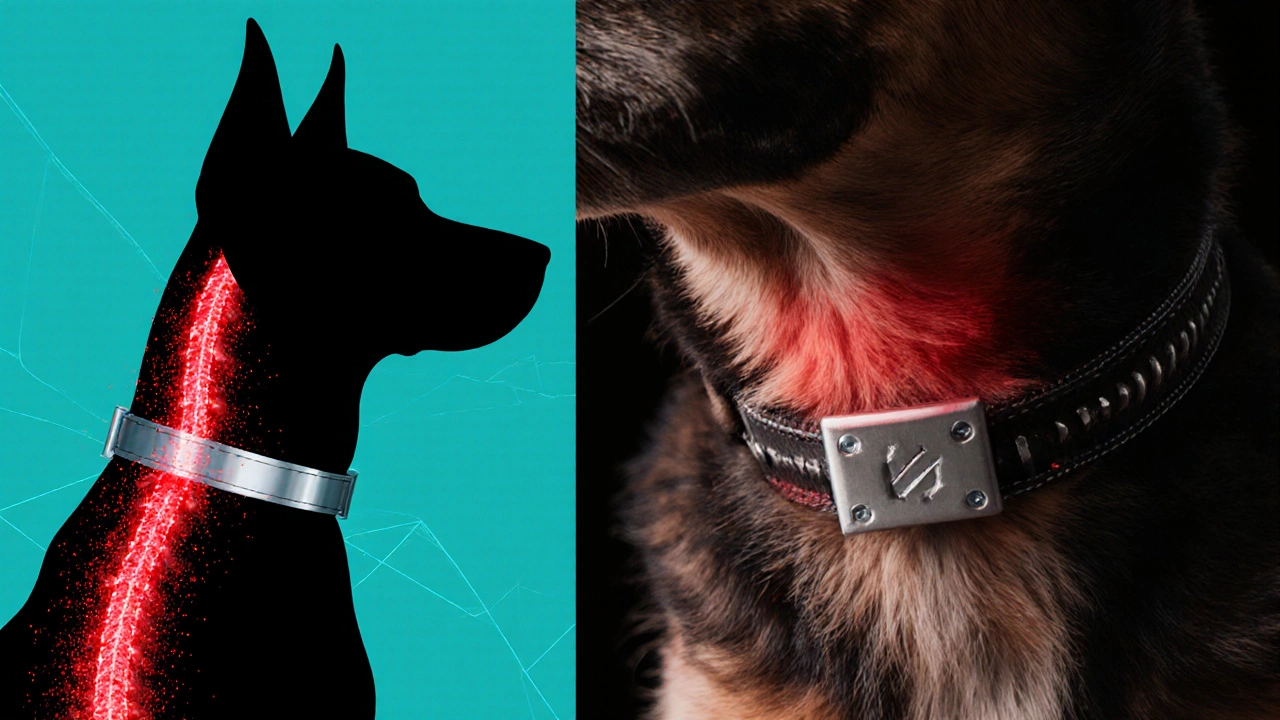
Ever wondered why a tiny buzz on a dog's neck can turn a playful pup into a trembling mess? The short answer: shock collars tap into fear, not learning. Below we break down how these devices work, the hidden costs to your canine's health, and what humane alternatives actually get results without the pain.
What a Shock Collar is
Shock Collar is a remote‑controlled device that delivers an electric pulse to a dog’s neck when a trigger (often barking or crossing a boundary) is detected. The unit consists of a battery pack, a metal contact plate, and a receiver on the dog’s neck. When the receiver picks up a signal from the handheld transmitter, it discharges a brief high‑voltage pulse.
How the device actually affects a Dog
A Dog is a mammal with a highly responsive nervous system. When a shock is delivered, the animal’s body releases stress hormones, especially Cortisol. Elevated cortisol over time can suppress immune function, cause chronic anxiety, and even lead to aggressive outbursts.
Physical and psychological fallout
- Skin irritation: The metal contact plate can cause burns, hair loss, or infection if it rubs against moist fur.
- Learned fear: Dogs quickly associate the painful stimulus with anything nearby - the yard, the leash, or the owner’s voice.
- Escalating aggression: A startled dog may bite the collar, the transmitter, or a human in an effort to escape the sensation.
- Reduced trust: When the owner is the source of pain, the bond weakens, making future training harder.

Legal and ethical landscape (2025 edition)
In New Zealand, the Animal Welfare Act 1999 prohibits any device that causes unnecessary suffering. While shock collars are not outright banned, the Ministry for Primary Industries has issued guidance urging trainers to adopt “positive, reward‑based methods.” Many European countries have already outlawed their sale, and several U.S. states are moving in the same direction.
Humane alternatives that work
If you’re looking for a training method that respects your dog’s wellbeing, consider these tried‑and‑tested options:
| Method | Effectiveness (short‑term) | Welfare Impact | Average Training Time | Best For |
|---|---|---|---|---|
| Shock Collar | Moderate | High stress, potential aggression | 2‑4 weeks (often with setbacks) | Quick bark suppression (but risky) |
| Clicker Training | High | Low stress, builds trust | 4‑6 weeks | Obedience, tricks, impulse control |
| Positive Reinforcement (treats, praise) | High | Very low | 3‑5 weeks | General behavior shaping |
| Remote Training Device (tone/vibration) | Medium | Low to moderate (no shock) | 5‑7 weeks | Recall training at distance |
The table makes it clear: rewarding good behavior consistently outperforms punishing bad behavior with electricity. When a dog learns that a specific action earns a tasty treat, the brain releases dopamine - the exact opposite of the cortisol spike caused by a shock.

Steps to transition away from a shock collar
- Remove the device gently. Give your dog a calm environment and a few minutes of free play.
- Identify the unwanted behavior. Is it excessive barking, jumping, or pulling on a leash?
- Choose a reward. High‑value treats, a favorite toy, or a burst of affectionate praise work well.
- Mark the right moment. Use a clicker or a consistent verbal cue (e.g., “yes!”) the instant the dog does the desired action.
- Practice in short sessions. 5‑10 minutes, several times a day, keeps motivation high.
- Gradually increase difficulty. Add distance, distractions, or mild duration before rewarding.
- Monitor stress signals. If you notice ears back, tail tucked, or rapid panting, step back and reduce pressure.
For stubborn cases, a Veterinary Behaviorist can assess anxiety levels and suggest a tailored behavior‑modification plan.
Common myths busted
- Myth: Shock collars are “humane” because the pulse is brief.
Fact: Even a split‑second jolt triggers a fight‑or‑flight response, which can scar a dog’s emotional well‑being. - Myth: If I only use the collar occasionally, it’s safe.
Fact: Inconsistent punishment creates confusion, leading to more anxiety and unpredictable reactions. - Myth: Only “aggressive” dogs need a shock collar.
Fact: Most owners resort to it out of frustration, not because the dog is inherently dangerous.
Bottom line
The short answer to the title’s question is clear: shock collar dogs experience unnecessary pain, heightened stress, and a weaker bond with their people. Reward‑based methods keep tails wagging, brains buzzing with dopamine, and owners stress‑free.
Do shock collars cause permanent damage?
Repeated electric shocks can lead to skin burns, chronic anxiety, and in severe cases, behavioral aggression. While physical damage may heal, the psychological scars often persist.
Are there legal restrictions on shock collars in New Zealand?
The Animal Welfare Act prohibits any device that causes unnecessary suffering. Although shock collars aren’t outright banned, the Ministry advises using positive reinforcement methods instead.
What’s the most effective humane alternative for bark control?
A combination of “quiet” cue training, proper exercise, and rewarding silent periods works best. Some owners also use vibration‑only remote devices, which avoid shock entirely.
How quickly can a dog recover after stopping a shock collar?
Recovery varies. Most dogs show reduced anxiety within a few weeks of consistent positive reinforcement. Severe cases may need professional behavior therapy.
Can a shock collar be used safely on puppies?
Absolutely not. Puppies are still developing neurologically and are far more vulnerable to stress. Early‑life positive training sets a foundation for lifelong trust.





